Solutions for Chapter 2 - Conversion and Reactor Sizing
P2-1. This problem will keep students thinking about writing down what they learned every chapter.
P2-2. This “forces” the students to determine their learning style so they can better use the resources in the text and on the CDROM and the web.
P2-3. ICMs have been found to motivate the students learning.
P2-4. Introduces one of the new concepts of the 4th edition whereby the students “play” with the example problems before going on to other solutions.
P2-5. This is a reasonably challenging problem that reinforces Levenspiels plots.
P2-6. Straight forward problem alternative to problems 7, 8, and 11.
P2-7. To be used in those courses emphasizing bio reaction engineering.
P2-8. The answer gives ridiculously large reactor volume. The point is to encourage the student to question their numerical answers.
P2-9. Helps the students get a feel of real reactor sizes.
P2-10. Great motivating problem. Students remember this problem long after the course is over.
P2-11. Alternative problem to P2-6 and P2-8.
P2-12. Novel application of Levenspiel plots from an article by Professor Alice Gast at Massachusetts Institute of Technology in CEE.
CDP2-A Similar to 2-8
CDP2-B Good problem to get groups started working together (e.g. cooperative learning).
CDP2-C Similar to problems 2-7, 2-8, 2-11.
CDP2-D Similar to problems 2-7, 2-8, 2-11.
Summary Assigned Alternates Difficulty Time (min) P2-1 O 15 P2-2 A 30 P2-3 A 30
Assigned
= Always assigned, AA = Always assign one from the group of alternates,
O = Often, I = Infrequently, S = Seldom, G = Graduate level
Alternates
In problems that have a dot in conjunction with AA means that one of the problems, either the problem with a dot or any one of the alternates are always assigned.
Time
Approximate time in minutes it would take a B/B+ student to solve the problem.
Difficulty
SF = Straight forward reinforcement of principles (plug and chug)
FSF = Fairly straight forward (requires some manipulation of equations or an intermediate calculation).
IC = Intermediate calculation required
M = More difficult
OE = Some parts open-ended.
* Note the letter problems are found on the CD-ROM. For example A CDP1-A. Summary Table Ch-2
P2-1 Individualized solution.
P2-2 (a) Example 2-1 through 2-3
If flow rate FAO is cut in half.
P2-4 O 75 P2-5 O M 75 P2-6 AA 7,8,11 FSF 45 P2-7 S FSF 45 P2-8 AA 6,8,11 SF 45 P2-9 S SF 15 P2-10 AA SF 1 P2-11 AA 6,7,8 SF 60 P2-12 S M 60 CDP2-A O 8,B,C,D FSF 5 CDP2-B O 8,B,C,D FSF 30 CDP2-C O 8,B,C,D FSF 30 CDP2-D O 8,B,C,D FSF 45
Straight forward 1,2,3,4,9 Fairly straight forward 6,8,11 More difficult 5,7, 12 Open-ended 12 Comprehensive 4,5,6,7,8,11,12 Critical thinking P2-8
v1 = v/2 , F1= FAO/2 and CAO will remain same. Therefore, volume of CSTR in example 2-3,
If the flow rate is doubled, F2 = 2FAO and CAO will remain same, Volume of CSTR in example 2-3, V2 = F2X/-rA = 12.8 m
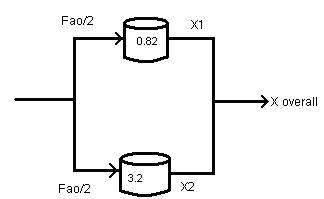
P2-2 (b) Example 2-4
X1
A r F 0 in Table 2-3 by 2. 0 X r F X A
and X2 =
0.8
0 X r F X A
A 2 3.2 2
A
3.2
2 1 2 1 0 1 1 A A A r X F r X F V
6.4
3
Now, FAO = 0.4/2 = 0.2 mol/s, Table: Divide each term A X 0 0.1 0.2 0.4 0.6 0.7 0.8 [FAO/-rA](m3) 0.445 0.545 0.665 1.025 1.77 2.53 4 Reactor 1 Reactor 2 V1 = 0.82m3 V2 = 3.2 m3 V = (FAO/-rA)X 1 0.82 1
Overall
(1/2)X1
(1/2)X2 = (0.546+0.8)/2 =
By trial and error we get:
= 0.546
conversion XOverall =
+
0.673
LevenspielPlot 0 0.5 1 1.5 2 2.5 3 3.5 4 4.5 0 0.2 0.4 0.6 0.8 1 Conversion Fao/-ra
P2-2 (c) Example 2-5 (1) For first CSTR, at X=0 ;
From previous example; V1 ( volume of first CSTR) = .188

Also the next reactor is PFR, Its volume is calculated as follows
Now the sequence of the reactors remain unchanged.
But all reactors have same volume.
First CSTR remains unchanged
Vcstr = .1 = (FA0/-rA )*X1 => X1 = .088 Now For PFR:
By estimation using the levenspiel plot X2 = .183
For CSTR,

0A A F r 1.28m3 at X=0.2 ; 0A A F r .94 m3
3
m
0.5 2 0.2 3 0.247 AO A F VdX r m For next CSTR, X3 = 0.65, 3 2 AOF m rA , V3 = 3 32 () .3 AO FXX m rA
(2)
2 0.088 X AO A F VdX r ,
(3) The worst arrangement is to put the PFR first, followed by the larger CSTR and finally the smaller
P2-3 Individualized solution.
P2-4 Solution is in the decoding algorithm given with the modules.

VCSTR2 = 32 3 0.1 AO FXX m rA => X3 = .316
CSTR. Conversion Original Reactor Volumes Worst Arrangement X1 = 0.20 V1 = 0.188 (CSTR) V1 = 0.23 (PFR) X2 = 0.60 V2 = 0.38 (PFR) V2 = 0.53 (CSTR) X3 = 0.65 V3 = 0.10 (CSTR) V3 = 0.10 (CSTR) For PFR, X1 = 0.2 1 1 0 X AO A F V dX r Using trapezoidal rule, XO = 0.1, X1 = 0.1 1 1 1 3 3 0.2 1 28 0 98 2 0.23 O O X X V f X f X rA m m For CSTR, For X2 = 0.6, 3 1.32 AOF m rA , V2 = 2 1 AO A F X X r = 1.32(0.6 – 0.2) = 0.53 m3 For 2nd CSTR, For X3 = 0.65, 3 2 AOF m rA , V3 = 0.1 m3
P2-5
V = 1.6 m 3
P2-5 (a) Two CSTRs in series
For first CSTR,
V = (FAo/-rAX1) X
=> X1 = 0.53
For second CSTR,
V = (FAo/-rAX2) (X2 – X1)
=> X2 = 0.76
P2-5 (b) Two PFRs in series
By extrapolating and solving, we get X1 = 0.62 X2 = 0.84

P2-5 (c)
Two CSTRs in parallel with the feed, FAO, divided equally between two reactors. FANEW/-rAX1 = 0.5FAO/-rAX1
V = (0.5FAO/-rAX1) X1
Solving we get, Xout = 0.68
P2-5 (d)
Two PFRs in parallel with the feed equally divided between the two reactors.
FANEW/-rAX1 = 0.5FAO/-rAX1
By extrapolating and solving as part (b), we get
Xout = 0.88
P2-5 (e)
X 0 0.1 0.2 0.4 0.6 0.7 0.8 FAO/-rA (m3) 0.89 1.08 1.33 2.05 3.54 5.06 8.0
1 2 1 0 X X Ao Ao A A X F F V dX dX r r
A CSTR and a PFR are in parallel with flow equally divided
Since the flow is divided equally between the two reactors, the overall conversion is the average of the CSTR conversion (part C) and the PFR conversion (part D)
Xo = (0.60 + 0.74) / 2 = 0.67
P2-5 (f)
A PFR followed by a CSTR,
XPFR = 0.50 (using part(b))
V = (FAo/-rA-XCSTR) (XCSTR – XPFR)
Solving we get, XCSTR = 0.70
P2-5 (g)
A CSTR followed by a PFR, XCSTR = 0.44 (using part(a))
X X A
PFR CSTR
AO dX r F V
By extrapolating and solving, we get XPFR = 0.72
P2-5 (h)
A 1 m3 PFR followed by two 0.5 m3 CSTRs, For PFR,
XPFR = 0.50 (using part(b))
CSTR1: V = (FAo/-rA-XCSTR) (XCSTR – XPFR) = 0.5 m3
XCSTR = 0.63
CSTR2: V = (FAo/-rA-XCSTR2) (XCSTR2 – XCSTR1) = 0.5 m3
XCSTR2 = 0.72
P2-6
Exothermic reaction: A B + C
P2-6 (a)
X r(mol/dm3.min) 1/-r(dm3.min/mol) 0 1 1 0.20 1.67 0.6 0.40 5 0.2 0.45 5 0.2 0.50 5 0.2 0.60 5 0.2 0.80 1.25 0.8 0.90 0.91 1.1
To solve this problem, first plot 1/-rA vs. X from the chart above. Second, use mole balance as given below.

For a feed stream that enters the reaction with a previous conversion of 0.40 and leaves at any conversion up to 0.60, the volumes of the PFR and CSTR will be identical because of the rate is constant over this conversion range.

CSTR: Mole balance: min / 5 4 0 /min 300 F V 3 A0 dm mol mol r X A CSTR => =>VCSTR = 24 dm3 PFR: Mole balance: X A A PFR r dX F V 0 0 = 300(area under the curve)
PFR = 72 dm3
V
P2-6 (b)
.6 .4 6 .4 0 .6 .4 0 0 X r F dX r F dX r F V A A A A A A PFR
CSTR = 105 dm3
A CSTR r XA0F V
P2-6 (c) V
Mole balance:
Use trial and error to find maximum conversion.
At X = 0.70, 1/-rA = 0.5, and X/-rA = 0.35 dm3.min/mol
Maximum conversion = 0.70
P2-6 (d)
From part (a) we know that X1 = 0.40.

P2-6 (e)
From part (a), we know that X1 = 0.40. Use trial and error to find X2 Mole balance:


At X2 = 0.908, V = 300 x (area under the curve)

=> V = 300(0.24) = 72dm3
Conversion = 0.908.
mol dm mol dm r X A min/ 35 0 /min 300 105 3 3
trial and
to
X2 Mole balance: 2 1 2 0 X A A r X X F V Rearranging, we get 008 0 0.40 0 2 2 A X A F V r X At X2 = 0.64, 0.008 0.40 2 2 X Ar X Conversion = 0.64
Use
error
find
2 2 40 0 40 0 0 300 72 X A X A A PFR r dX r dX F V
P2-6 (f)
See Polymath program P2-6-f.pol
From the plot of 1/-rS Calculate the area under the curve such that the area is equal to V/FS0 = 80 / 1000 = 0.08 X = 12% For the 80 dm

X/-rs = 0.08. From guess and check we get X = 55%
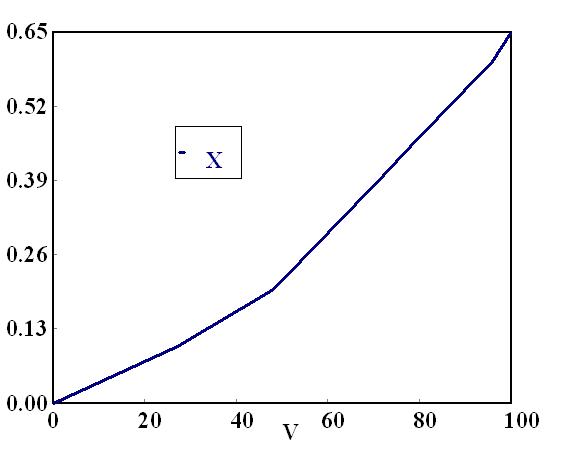
(a) S S r X F V 0 FS0 = 1000 g/hr At a conversion of 40% g hr dm rS 3 15 0 1 Therefore 3 60
At a conversion
g hr dm rS 3
S0
Therefore 3
X S S PFR r dX F V 0 0
P2-7
(1000)(0.40) 0.15 dm V P2-7 (b)
of 80%,
0.8 1 F
= 1000 g/hr
640 (1000)(0.80) 0.8 dm V P2-7 (c)
S
3 CSTR, S
r X F dm V 0 3 80
P2-7 (d)
To achieve 80% conversion with a CSTR followed by a CSTR, the optimum arrangement is to have a CSTR with a volume to achieve a conversion of about 45%, or the conversion that corresponds to the minimum value of 1/-rs. Next is a PFR with the necessary volume to achieve the 80% conversion following the CSTR. This arrangement has the smallest reactor volume to achieve 80% conversion
For two CSTR’s in series, the optimum arrangement would still include a CSTR with the volume to achieve a conversion of about 45%, or the conversion that corresponds to the minimum value of 1/-rs, first. A second CSTR with a volume sufficient to reach 80% would follow the first CSTR. P2-7 (e)
Let us first consider when CS is small.
CS0 is a constant and if we group together the constants and simplify then
since
which is consistent with the shape of the graph when X is large (if CS is small X is large and as CS grows X decreases).
Now consider when CS is large (X is small)
As CS gets larger CC approaches 0:
and
S M C S s C K C kC r and 001 0 1 0 0 S S C C C C S M S S S s C K C C kC r 0.001 0.1 0 0.001 0.1 1 0 S S S S M s C C kC C K r
Cs k C k C K r S S M s 2 2 1 1
C
< KM Cs k C k K r S M s 2 2 1 1
S
0.001 0.1 0 S S C C C C
0 S S C
C
And since CC is becoming very small and approaching 0 at X = 0, 1/-rs should be increasing with CS (or decreasing X). This is what is observed at small values of X. At intermediate levels of CS and X, these driving forces are competing and why the curve of 1/-rS has a minimum.

P2-8

If S M C S s C K C kC r then C S S M s C kC C K r 1 As CS grows larger, CS >> KM And C C S S s kC C kC C r 1 1
phase
2A + B 2C
Polymath
P2-8 Irreversible gas
reaction
See
program P2-8.pol.
(a)
Mole Balance 2 1 ) ( 0 X X A A r dX F V Volume = Geometric area under the curve of (FA0/-rA) vs X) 5 0 100000 5 0 400000 2 1 V V = 150000 m3
(b)
Mole Balance ) ( 0 A A r X F V 100000 0.5 V V = 50000m3
PFR volume necessary to achieve 50% conversion
P2-8
CSTR Volume to achieve 50% conversion
Volume of second CSTR added in series to achieve 80%

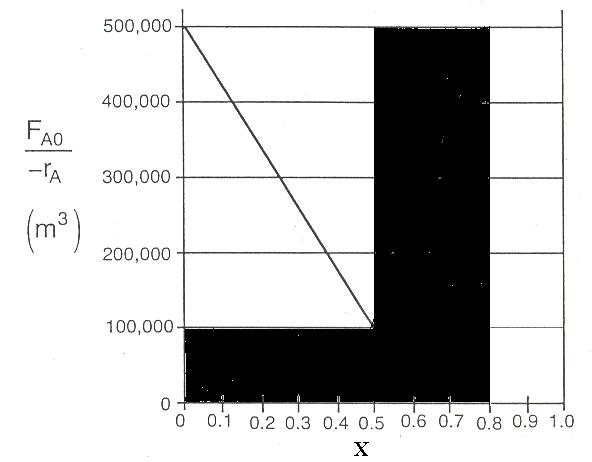
P2-8
Volume of PFR added in series to first CSTR to achieve 80%
P2-8(f)
Real rates would not give that shape. The reactor volumes are absurdly large.


P2-8 (c)
conversion ) ( ) ( 1 2 0 2 A A r X X F V 0.5) (0.8 500000 2V V2 = 150000m3
(d)
0.3) (100000 0.3) 400000 2 (1 PFRV VPFR = 90000m3 P2-8 (e) For CSTR, V = 60000 m3 (CSTR) Mole Balance X X r X F V A A 500000) 800000 ( 60000 ) ( 0 X = 0.463 For PFR, V
m3 (PFR) Mole balance X A A r dX F V 0 0 ) ( dX X X 100000) 800000 ( 60000 0 X = 0.134
conversion
= 60000
P2-9
Problem 2-9 involves estimating the volume of three reactors from a picture. The door on the side of the building was used as a reference. It was assumed to be 8 ft high.
The following estimates were made:
CSTR
h = 56ft d = 9 ft
V = πr 2h = π(4.5 ft)2(56 ft) = 3562 ft3 = 100,865 L
PFR
Length of one segment = 23 ft
Length of entire reactor = (23 ft)(12)(11) = 3036 ft
D = 1 ft
V = πr2h = π(0.5 ft)2(3036 ft) = 2384 ft3 = 67,507 L
Answers will vary slightly for each individual.
P2-10 No solution necessary.
P2-11 (a)
The smallest amount of catalyst necessary to achieve 80 % conversion in a CSTR and PBR connected in series and containing equal amounts of catalyst can be calculated from the figure below.
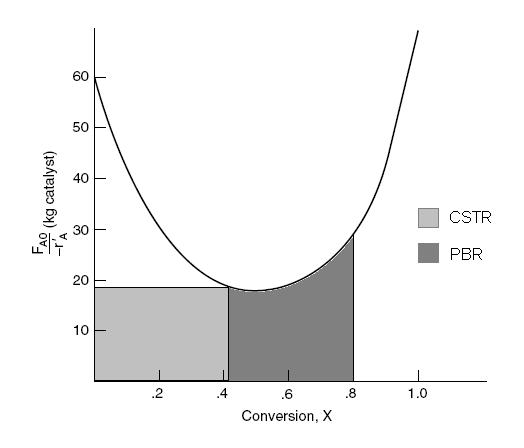
The lightly shaded area on the left denotes the CSTR while the darker shaded area denotes the PBR. This figure shows that the smallest amount of catalyst is used when the CSTR is upstream of the PBR. See Polymath program P2-11.pol
P2-11 (b)
Calculate the necessary amount of catalyst to reach 80 % conversion using a single CSTR by determining the area of the shaded region in the figure below.


The area of the rectangle is approximately 23.2 kg of catalyst.
P2-11 (c)
The CSTR catalyst weight necessary to achieve 40 % conversion can be obtained by calculating the area of the shaded rectangle shown in the figure below.
The area of the rectangle is approximately 7.6 kg of catalyst.
P2-11 (d)
The catalyst weight necessary to achieve 80 % conversion in a PBR is found by calculating the area of the shaded region in the figure below.
The necessary catalyst weight is approximately 22 kg.
P2-11 (e)
The amount of catalyst necessary to achieve 40 % conversion in a single PBR can be found from calculating the area of the shaded region in the graph below.

The necessary catalyst weight is approximately 13 kg.

P2-11 (f)
P2-11 (g)
For different (-rA) vs. (X) curves, reactors should be arranged so that the smallest amount of catalyst is needed to give the maximum conversion. One useful heuristic is that for curves with a negative slope, it is generally better to use a CSTR. Similarly, when a curve has a positive slope, it is generally better to use a PBR.
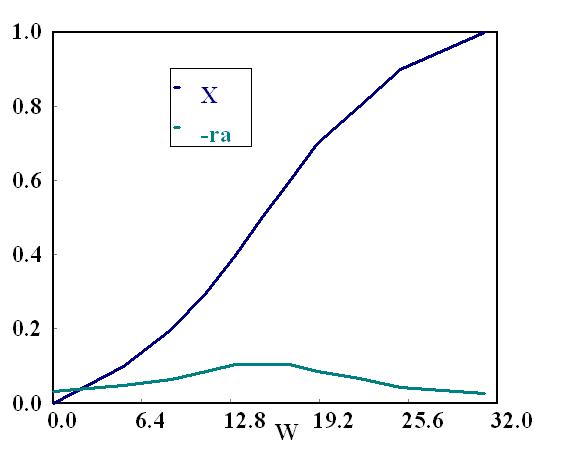
P2-12 (a) Individualized Solution
P2-12 (b) 1) In order to find the age of the baby hippo, we need to know the volume of the stomach. The metabolic rate, -rA, is the same for mother and baby, so if the baby hippo eats one half of what the mother eats then Fao (baby) = ½ Fao (mother). The Levenspiel Plot is shown:
0 0.5 1 1.5 2 2.5 3 3.5 4 4.5 5 0 0.2 0.4 0.6 0.8 mao/raM1 Conversion AutocatalyticReaction Mother Baby
Since the volume of the stomach is proportional to the age of the baby hippo, and the volume of the baby’s stomach is half of an adult, then the baby hippo is half the age of a full grown hippo.
4.5 2 25 2 years Age years
2) If Vmax and mao are both one half of the mother’s then
will be identical for both the baby and mother.
Assuming that like the stomach the intestine volume is proportional to age then the volume of the intestine would be 0.75 m3 and the final conversion would be 0.40
P2-12 (c)
Vstomach = 0.2 m3
From the web module we see that if a polynomial is fit to the autocatalytic reaction we get:

3 1.36*0 34 0 23 2 baby A FaoX V m r
0 2 2 1 2 mother A Ao AM AM m m r r and since max 2 A AM M A v C r K C then max 2 2 1 1 2 2 baby mother A AM AM M A v C r r K C 2 2 2 1 2 1 2 Ao Ao Ao AM AM mother baby AM mother m m m r r r 2 Ao AM m r
0 1 A AM m r = 127X4 - 172.36X3 + 100.18X2 - 28.354X + 4.499
And since Vstomach = 0
solve
Xstomach = .067.
For the intestine, the Levenspiel plot for the intestine is shown below. The outlet conversion is 0.178 Since the hippo needs 30% conversion to survive but only achieves 17.8%, the hippo cannot survive.


P2-12 (d)
PFR CSTR
PFR: Outlet conversion of PFR = 0.111

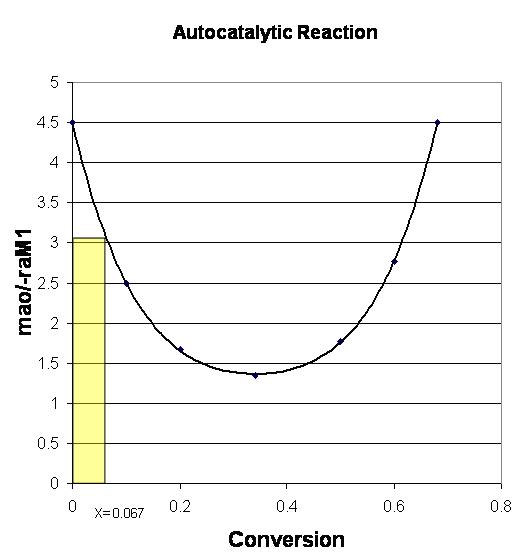
1 A AM m r
3
28.354X2
=
m3
X,
V= 127X5 - 172.36X4 + 100.18X
-
+ 4.499X
0.2
of Chemical Reaction Engineering 1st Edition Fogler Solutions Manual Full Download: http://testbanktip.com/download/essentials-of-chemical-reaction-engineering-1st-edition-fogler-solutions-manual/ Download all pages and all chapters at: TestBankTip.com
Essentials






























